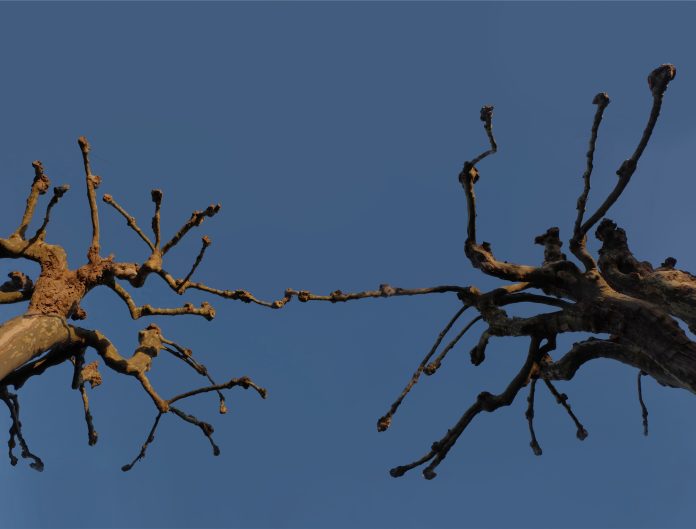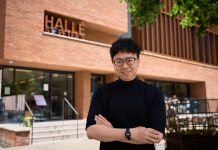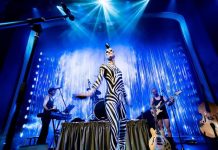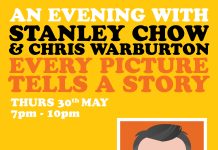The Gallery is featuring solo work from three artists, Nick Jordan, Parham Ghalamdar and Chris Paul Daniels.
Featuring works that span film,photography, painting and sculpture, these three solo exhibitions offer an exciting opportunity to see the
work of three artists at critical stages in their careers.
Natural Interaction, a solo exhibition by artist Nick Jordan.
Featuring new films, prints, photographs, painting and sculptural works, the exhibition explores the interdependencies between social and ecological healthcare or wellbeing.
Drawing upon the artist’s recent collaborations with ecologists, materials scientists, and healthcare professionals involved in medical genetics, the work interconnects the lived experience of rare health conditions with the reciprocal behaviours and symbiotic systems found in nature.
A new film trilogy (Rare Frequencies, Genetic Sequences and The Entangled Forest) captures the unique features of ecologically diverse habitats which sustain many rare or endangered species, playing a vital role in mitigating the impacts of climate change. Combined with audio conversations that reflect upon the importance of science and the lessons we can learn from nature, Jordan’s hybrid documentaries explore diverse landscapes and ecosystems, including restored peatlands, networks of mycelium, botanical gardens, urban woodlands and ancient forests; threading together themes of community and mutuality, resilience and renewal.
Rare Frequencies draws upon conversations with people impacted by rare diseases, as well as health practitioners involved in medical genetics and counselling. Jordan combines the discussions with footage he filmed at a restored peatland habitat on the edge of Manchester, which now hosts many rare species of wildlife.
Genetic Sequences continues the conversations with medical geneticists and psychologists, filmed in Vienna for the European Society of Human Genetics. The discussions reflect on interrelated issues such as global healthcare inequalities, access to vaccines, trust in science and hopes for the future. Shot in a single weekend, the film captures an urban topography, from public parks and city streets to the global plant collection of the University of Vienna’s Botanical Garden.
Completing Jordan’s trilogy of new films is The Entangled Forest, which explores the reciprocal, shared behaviours that exist between trees and fungi. Filmed from the heat of late summer to the frozen depths of winter, in diverse woodland habitats, the documentary features the voice of ecologist Suzanne Simard, and her ground-breaking research into the ‘biological neural network’ of forest ecosystems.
Each of the films feature an atmospheric and textural soundtrack score, recorded with traditional folk instruments, woodwind and analogue synths, composed by Otis Jordan (Rare Frequencies and Genetic Sequences) and Otis Jordan and Lord Mongo (The Entangled Forest).
Creating dialogue and interconnections with the films are a series of new works by the artist, including mushroom spore prints presented as a family tree, archival botanical drawings, a greenhouse, and a living micro habitat of native bog plants.
Painting, An Unending, a solo show of new work by Parham Ghalamdar, his largest institutional exhibition to date.
His work draws on traditions of Persian and Western art, graffiti, internet and digital culture. Elements abstracted from a range of personal and cultural references such as Piero de la Francesca’s fresco Dream of Constantine and objects from American cowboy cartoons or sci-fi refences consumed during his childhood in Iran, are painted against bleak landscapes creating often absurdly humorous epic scenes. Eschewing narrative, he approaches his work as a performer warming up their vocal cords, shape shifting colour with texture, surface quality and composition to infuse a dreamlike, surreal sensibility.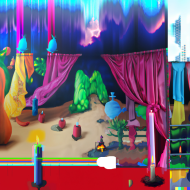
The tent featured in Francesca’s 15 Cent. fresco Dream of Constantine is used as a trope throughout Painting, An Unending. Located in a church in Arezzo, Italy, the fresco depicts the night before the Battle of Milvern Bridge, fought between the Roman Emperors Constantine and Maxentius. Historicised as the event that marked the death of paganism and the birth of Christianity as the dominant religion for the empire and Europe, the work symbolises a significant turning point in social, cultural and political consciousness. As such, for Ghalamdar, the work signifies a moment of pause, an ‘in between state’; flickering between past and future; charged ambiguity or promise. Autobiographically, the work resonates as a state of transition, migration and shelter.
For Painting, An Unending, he has used an artificial intelligence tool that creates realistic images from text descriptions, as an extension of his sketchbook. Testing the AI generator’s capabilities in rendering the aesthetics of the classic masters’ into an image, he prompts it with social scenes or situations that due to his political beliefs or sexuality would be impossible in his homeland. The results appear surprising and random. Incorporating them into his work, he repaints and repeats the process endlessly. The work jumps from one epoch or socio/political order to another within the same canvas, exploring notions of identity politics, migration, freedom of movement, boarders, community and belonging.
Is there anybody there? a solo show by artist filmmaker, Chris Paul Daniels.
His work responds to place, merging communal memory with experimental observation and fictional narration. For this exhibition, Daniels has sourced 70 different films from the North West Film Archive at Manchester Metropolitan University, editing them together to create a monumental study of cultural traditions, procession and ceremony. Guided by the unseen presence of a disembodied voice, the artist’s fictional script and original musical score composed by Graham Massey (808 State, Massonix), reanimate past archival footage whilst addressing how film can be authored and mediated.
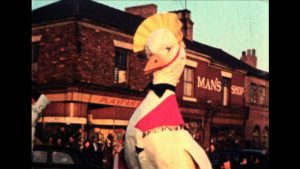 Original footage from across the North West has been shot by enthusiasts in their homes, on the street, by local film societies or professional productions, on media ranging from super 8 or 16mm film to analogue and digital video. The films feature elaborate costumes of popular and imaginary figures, people performing puppetry or magic tricks, competitive weightlifting, high wire acrobatics, community arts performances, or parades such as Whit walks, pageants and pride marches from as early as 1901 to the present day.
Original footage from across the North West has been shot by enthusiasts in their homes, on the street, by local film societies or professional productions, on media ranging from super 8 or 16mm film to analogue and digital video. The films feature elaborate costumes of popular and imaginary figures, people performing puppetry or magic tricks, competitive weightlifting, high wire acrobatics, community arts performances, or parades such as Whit walks, pageants and pride marches from as early as 1901 to the present day.
Edited together to create a continuous flowing choreography, Is there anybody there? explores notions of individual and collective archival memory, how it is created, by whom, (posing questions around who had the means to access the camera) and consequently whose stories, identities or cultures may be missing.
Daniels uses the archival footage as a malleable material to be sculpted, fragmented, collapsing and disrupting the chronology of time, dancing from one era or location to another. The composition of image, narrative and score are developed intuitively and in dialogue, both informing the other as the narrative evolves. The single voice narration meanders from benignly descriptive, speculative, teasing the viewer with visual jokes, to declaratory or conveying allusions to being summoned, and through the conflation with moving image, the film takes on a sentient presence.
In this film, archival footage normally presented as evidence, becomes mere speculation; a metaphor for the uncanny or past lives. Fascinated by the slippages between what is real and what is not, the artist explores how historical events morph between legend, myth or folklore, or how endlessly performed rituals can become estranged out of time. The precarity of the narrative of history is exposed through fictions told by an unreliable narrator and proposes new stories to make sense of our lives for a parallel present or a projected future

